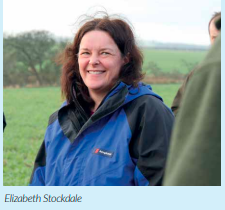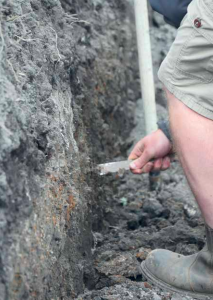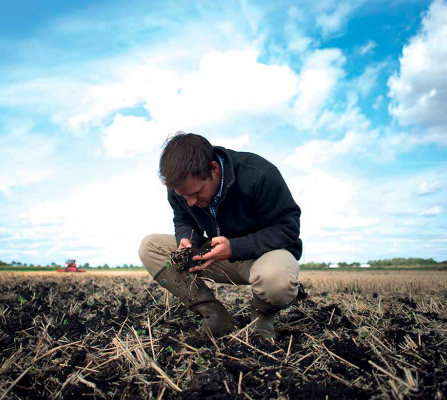How much do you really know about your soil and its health? Elizabeth Stockdale, NIAB and knowledge exchange lead for the AHDB Soil Biology and Soil Health Partnership takes a closer look.

Recent work on soil management carried out by AHDB with grower groups across the country highlighted a lack of information on soil biology and soil health. Soil physics, chemistry and biology are interlinked and all play a role in maintaining productive agricultural and horticultural systems. While physical and chemical properties of soil are relatively well understood, the same is not necessarily true for soil biology. Soils contains a very high diversity of organisms. Until recently only around one per cent of all soil micro-organisms had been identified. Soil organisms interact with one another and the chemical and physical properties of the soil to drive soil processes, such as:
• Release and recycling of nutrients
• Forming and maintaining soil structure to maintain water and aeration
• Both causing and controlling plant diseases and pests
• Nitrogen fixation or increasing nutrient availability through beneficial relationships with plant roots
Together interactions between soil physical, chemical and biological factors contribute to soil health. In the same way we measure our own health by our ability to carry out our normal everyday tasks, healthy soil can be recognised by its outputs/functions i.e. healthy plants, animals and ultimately humans.

It is useful to consider whether we can identify underlying indicators that help us identify when soil is in a healthy or unhealthy state – the equivalent of taking a soil’s blood pressure and temperature. Because of the wide range of soil types, climates and farming systems in the UK, it is important to put such indicators into context. AHDB’s GREATsoils programme pulls these three factors together and provides valuable information on soil management for growers and agronomists. Funded in 2016, the Soil Biology and Soil Health Partnership aims to fill a gap in knowledge and help farmers and growers manage soil health better.

The Soil Biology and Soil Health Partnership, 2017-2021
Funded by AHDB and BBRO, the five-year Soil Biology and Soil Health Partnership is a series of cross-sector research and knowledge exchange projects. Each is designed to help farmers and growers maintain and improve the productivity of UK agricultural and horticultural systems. The key output of the Partnership will be a toolkit including an integrated scorecard to help growers measure and manage soil health. All the outputs will be designed with farmers and growers so they can be easily understood.
The Partnership comprises eight scientific partners and six industry partners and this breadth of expertise provides a robust practical and scientific foundation. However, we recognise that farmers and growers have already taken the initiative to understand the health of their own soils and a great deal of work is already being done on-farm to experiment with ways to optimise soil biology and health.
Therefore, from its outset the Partnership has sought to work closely with farmers, growers and advisers to draw together and build on current knowledge and experience. Crucially, the Partnership will also involve key players in the agri-food sectors to direct the work and maximise the practical relevance of its findings in modern farming rotations.
Findings so far
In the first year of the programme, we have:
• Updated scientific reviews of soil biology and soil health
• Developed a model that provides an easily understood summary of the effects of soil management on soil biology and soil health
• Identified a set of methods to measure soil health on-farm which can be used to support practical decision-making
• Reviewed molecular-based
approaches that can be applied to assess soil biological function In recent years, a range of indicators for soil biology have been developed. It is now possible to measure soil chemical, physical and biological properties. Some of the best measures of soil physical structure and its stability can be completed in the field whereas most chemical properties need samples to be sent away for analysis. The recommended biological indicators may be assessed in the field (earthworms) or sent away for analysis (soil respiration).
However, often these indicators have not been produced in parallel with the necessary guidance and tools to allow them to be easily used on farm. We have selected some indicators for testing where we will focus on whether the target values/thresholds for soils/ farming systems are correct e.g. soil organic matter levels. We are also trying out new DNA-based indicators of the soil biological community in practice.
What next?
Over the next three years, we are working on pre-existing long-term soil management trials and on commercial farms to evaluate the performance of the model and to evaluate a new soil health scorecard. This work includes trials on raspberry, onion and narcissus. Seven long-term soil management trials have been identified which have treatments in place that target the main influences on biological function:
• Food source – nutrient and organic matter inputs, cropping choice and sequence
• Air and water supply – tillage systems and drainage
• Chemical environment – pH
Across these trials and commercial farms, a programme providing detailed monitoring of crop (yield, disease and weed constraints) and rotational soil health is now in place. Soil sampling takes place in the autumn post-harvest and after the soil has wetted up. A key part of sampling for rotational soil health is the linking of measures of soil physical, chemical and biological properties.

As soils need to be moist, sampling may take place post-cultivation/drilling of winter crops, but leaving a gap of at least one month after soil disturbance. Soil physical properties and numbers of earthworms are recorded in the field at the time of sampling and we are also collecting cores for the measurement of bulk density.

A bulk soil sample is collected to allow extended soil chemical and biological analysis using the NRM Soil Health package plus direct measures of soil organic carbon, total nitrogen, potentially mineralisable nitrogen, microfauna and nematodes. The same soil samples will also be used in the development and validation of DNAbased soil biological indicators. To allow control of the factors under study, many research trials have specific and narrowly focused remits, often with limited acknowledgement of rotational impacts. Consequently, implementation and impact of soil management on farms has been less well studied. The Soil Biology and Soil Health Partnership is deliberately taking another approach and is working with farmer and grower research-innovation groups to evaluate the impacts on soil biology and health across a broad spectrum of crops including field vegetables, climates, soil types and rotations.
For more information on soil biology
and soil health visit:
www.ahdb.org.uk/greatsoils
